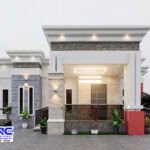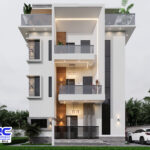Cracks in RCC (Reinforced Cement Concrete) slabs are one of the most common issues faced in Nigerian construction.
They not only affect the beauty of a building but can also compromise structural integrity if left unchecked.
Fortunately, most of these cracks are preventable with the right approach during construction.
So, how can you prevent cracks in RCC slabs in Nigeria?
This will cover everything from design to finishing that will help you build crack-free, durable slabs.
Table of Contents
ToggleSee also – How Many Days Does It Take for a Newly Poured RCC Slab Decking to Dry?

Types of Common Cracks in RCC Slabs
Before learning how to prevent cracks, it’s important to understand the types:
- Shrinkage Cracks: Due to rapid drying or lack of curing
- Structural Cracks: Caused by overloading or poor reinforcement
- Thermal Cracks: Due to temperature changes and heat of hydration
- Settlement Cracks: From uneven support or weak substructure
Causes of RCC Slab Cracks in Nigeria
- Poor quality cement or aggregates
- Improper water-cement ratio
- Inadequate curing
- Insufficient reinforcement
- Improper mixing or compaction
- Removal of formwork too early
- Unskilled labour or lack of supervision
How to Prevent Cracks in RCC Slabs
1. Use Quality Cement and Materials
- Use PPC or OPC 42.5/53 Grade from trusted brands like Dangote, BUA, Lafarge, or Ashaka.
- Avoid expired cement or poorly stored bags.
- Use well-graded aggregates and clean, potable water.
2. Follow the Right Water-Cement Ratio
- Too much water weakens the mix and increases shrinkage.
- For slab work, the ideal water-cement ratio should be 0.45 to 0.50.
3. Proper Reinforcement Design and Placement
- Always use a structural engineer’s design.
- Ensure correct bar spacing, diameter, and cover.
- Use spacers or cover blocks to prevent reinforcement from touching the formwork.
4. Mix and Place Concrete Correctly
- Use mechanical mixers for consistency.
- Avoid delays between mixing and pouring.
- Ensure proper compaction using a vibrator to remove air pockets.
5. Don’t Remove Formwork Too Early
- Wait at least 7 days before removing bottom supports of slabs.
- For large spans, keep supports for up to 14–21 days, depending on slab thickness and concrete grade.
6. Cure Properly and Consistently
- Start curing 24 hours after pouring.
- Keep the slab surface moist for at least 7–14 days.
- Use water spraying, ponding, or wet coverings (like hessian cloth).
7. Avoid Overloading the Slab Early
- Don’t allow workers to store blocks or heavy materials on freshly cast slabs.
- Allow 28 days for full strength development before heavy work begins.
8. Protect Against Extreme Weather
- During dry/hot weather (common in Nigeria), concrete dries fast and causes cracks.
- Use sunshades, wet coverings, or delay casting till cooler parts of the day.
9. Use Admixtures If Necessary
Chemical admixtures like plasticizers, retarders, or shrinkage reducers can help prevent cracks in complex or large-scale projects.
Extra Tips for Nigerian Builders and Homeowners
- Always have a qualified engineer or site supervisor on-site.
- Don’t cut corners to save money on materials or workmanship.
- Regularly inspect the reinforcement, formwork, and curing process.
Conclusion
Cracks in RCC slabs are often a result of poor planning, low-quality materials, and inadequate supervision.
In Nigeria, where weather, material sourcing, and labour skills vary, it’s essential to follow best practices during every stage of construction.
By using quality materials, following correct procedures, and ensuring proper curing, you can prevent cracks and ensure your slab remains strong and durable for years.
Build it once. Build it right.
Frequently asked questions
What type of cement is best for RCC slab decking in Nigeria?
Portland Pozzolana Cement (PPC) is often preferred for its durability, cost-effectiveness, and resistance to aggressive environmental conditions.
Why is PPC better than OPC for slab decking?
PPC generates less heat during curing, reducing the risk of cracks, and offers better long-term strength and chemical resistance.
Can OPC be used for RCC slab decking?
Yes, Ordinary Portland Cement (OPC) is suitable for projects requiring quick setting and high initial strength, such as industrial or commercial structures.
What grades of cement are recommended for RCC slabs?
Grades like 42.5 and 52.5 are ideal for RCC slabs due to their high compressive strength.
How do I choose the right cement for my project?
Consider factors like budget, environmental conditions, and structural requirements.
PPC is great for residential slabs, while OPC is better for heavy-duty projects.









